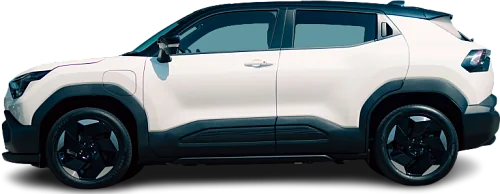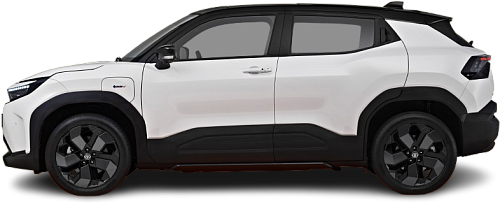USA EV Comparison: Suzuki e Vitara 61 kWh FWD vs Toyota Urban Cruiser 61.1 kWh FWD
Struggling to Decide? Let AI Help!
Your AI Summary Is Ready!
General Info
While both vehicles are currently in production, they are not sold in the United States.
The two vehicles share the same body style: SUV.
| Property | Suzuki e Vitara 61 kWh FWD | Toyota Urban Cruiser 61.1 kWh FWD |
|---|---|---|
| Years of Production | 2025-… | 2025-… |
| Current Status | Produced | Produced |
| Country of Manufacture | India | India |
| Body Style | SUV | SUV |
| Market Availability | EU | EU |
| GCC Score | 5.8 | 5.9 |
Range and Efficiency
The two vehicles are identical in terms of range, battery pack capacity, and energy efficiency.
| Property | Suzuki e Vitara 61 kWh FWD | Toyota Urban Cruiser 61.1 kWh FWD |
|---|---|---|
| Range (WLTP) | 265 mi | 265 mi |
| Range (GCC) | 225 mi | 225 mi |
| Battery Capacity (Nominal) | 61.1 kWh | 61.1 kWh |
| Battery Capacity (Usable) | 59.8 kWh | 59.8 kWh |
| Efficiency per 100 mi | 26.6 kWh/100 mi | 26.6 kWh/100 mi |
| Efficiency per kWh | 3.76 mi/kWh | 3.76 mi/kWh |
| Range and Efficiency Score | 6.8 | 6.8 |
Charging
Both vehicles utilize a standard 400-volt architecture.
The Suzuki e Vitara 61 kWh FWD (2025-…) offers faster charging speeds at DC stations, reaching up to 70 kW, while the Toyota Urban Cruiser 61.1 kWh FWD (2025-…) maxes out at 55 kW.
Both vehicles are equipped with the same on-board charger, supporting a maximum AC charging power of 11 kW.
| Property | Suzuki e Vitara 61 kWh FWD | Toyota Urban Cruiser 61.1 kWh FWD |
|---|---|---|
| Max Charging Power (AC) | 11 kW | 11 kW |
| Max Charging Power (DC) | 70 kW | 55 kW |
| Architecture | 400 V | 400 V |
| Charge Port | CCS Type 2 | CCS Type 2 |
| Charging Score | 5.6 | 5.6 |
Performance
Both vehicles are front-wheel drive.
With equal motor power, both cars deliver the same 0-60 mph acceleration time.
| Property | Suzuki e Vitara 61 kWh FWD | Toyota Urban Cruiser 61.1 kWh FWD |
|---|---|---|
| Drive Type | FWD | FWD |
| Motor Type | PMSM | PMSM |
| Motor Power (kW) | 128 kW | 128 kW |
| Motor Power (hp) | 172 hp | 172 hp |
| Motor Torque | 139 lb-ft | 142 lb-ft |
| 0-60 mph | 8.4 s | 8.4 s |
| Top Speed | 93 mph | 85 mph |
| Performance Score | 2.8 | 2.8 |
Dimensions
The Suzuki e Vitara 61 kWh FWD (2025-…) and Toyota Urban Cruiser 61.1 kWh FWD (2025-…) are about the same size.
Both models have similar wheelbase lengths.
| Property | Suzuki e Vitara 61 kWh FWD | Toyota Urban Cruiser 61.1 kWh FWD |
|---|---|---|
| Length | 168.3 in | 168.7 in |
| Width (with Mirrors) | 81.3 in | 81.3 in |
| Width (w/o Mirrors) | 70.9 in | 70.9 in |
| Height | 64.4 in | 64.4 in |
| Wheelbase | 106.3 in | 106.3 in |
Cargo and Towing
Both models provide equal trunk space and the same total cargo volume when the rear seats are folded.
Neither car is equipped with a frunk (front trunk).
The Toyota Urban Cruiser 61.1 kWh FWD (2025-…) has a towing capacity of up to 1654 lb, whereas the Suzuki e Vitara 61 kWh FWD (2025-…) is not officially rated for towing in the US.
| Property | Suzuki e Vitara 61 kWh FWD | Toyota Urban Cruiser 61.1 kWh FWD |
|---|---|---|
| Number of Seats | 5 | 5 |
| Curb Weight | 4045 lb | 4045 lb |
| Cargo Volume (Trunk) | 8.4 ft3 | 8.4 ft3 |
| Cargo Volume (Max) | 19.8 ft3 | 19.8 ft3 |
| Cargo Volume (Frunk) | - Cargo Volume (Frunk) | - Cargo Volume (Frunk) |
| Towing Capacity | - Towing Capacity | 1654 lb |
| Cargo and Towing Score | 5.8 | 6.2 |




